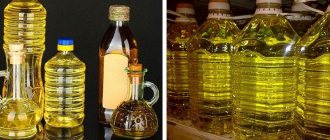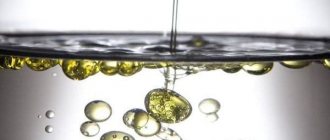Rules for flushing the intercooler
When cleaning the heat exchanger, do not use devices with pressurized water supply. The pressure can damage the aluminum plates. The type of detergent does not particularly affect the result. There are two ways to wash:
- external;
- internal.
The first method allows you to flush the intercooler without removing it; the second method requires dismantling. During the cleaning process, various cleaners for radiators and engines, gasoline, kerosene, and solvent are used. Almost any product that copes well with severe stains will do.
The removed cooler can be washed better, since most of the foreign particles accumulate on the back side. The choice of method depends on the car’s mileage, degree of contamination and conditions of use. If oil gets into the intercooler, it must be cleaned twice. First, all dirt and salt deposits are removed, and then the surface is washed from oil. Gasoline and kerosene work well with this substance.
The need to disassemble the front panel and bumper depends on the car model and the location of the heat exchanger. In some cases, only dismantling the arch protection will be required. By carrying out external cleaning, you can avoid disassembling the device, but washing it will be much worse. To remove external contaminants, you will need a hose with low water pressure, a cleaning agent and a soft brush.
To remove the air intercooler, the clamps are loosened and the fasteners are disconnected. Water devices require the dismantling of all pipes. If there is a lot of dirt on the device, it is necessary to carry out mechanical cleaning. All kinds of growths, stones, and insects are removed. Curved plates are straightened using improvised means. Chemical means are used to remove deposits and dirt; you can use Profoam 2000. Internal parts are washed with acetone, white spirit, kerosene or engine and carburetor cleaners.
Cleaning the intercooler is a simple process that, together with drying, takes the driver 2-3 hours. Timely replacement of pipes will avoid breakdowns and costly engine repairs.
Importance of Cleaning
Any vehicle component is subject to contamination during operation, the intercooler is no exception. Off-road driving, contact of aluminum parts with mixtures of slag, sand and salt - all this leads to the appearance of plaque on the components of the device, deteriorating its performance. The heat exchanger in the front of the car absorbs all the dirt flying from under the wheels of the vehicle ahead.
The salts react with the aluminum and create deposits on the plates. The accumulated oil binds all the adhered particles into a dense mixture, which significantly increases the load on the cooler and reduces its operation to zero. A mass of pollutants prevents the full passage of air through the tubes, so it is important to flush the inside of the intercooler.
Purpose and features
Changing the oil in a car, which oil is thicker than 5w30 or 10w 40
Intercooler is a heat exchanger that cools the hot air coming from the turbocharger. The temperature can reach +200 °C, which is due to the heating of the compressor and the compression of air flows. There are two types of intercooler cooling:
- air;
- aquatic
In the first case, the radiator releases excess heat into the atmosphere. The simple design has made this type the most popular among car manufacturers. The second type involves cooling with water. The unit has a compact size and high operating efficiency. Its structure is more complex and includes an additional liquid cooler, a transfer pump, and a control system.
Externally, the intercooler is a radiator with many strokes, plates and tubes that dissipate heat. The long length of the nozzles and their absence of bends make it possible to maintain high pressure in the structure.
The operating efficiency of the device is very high. The engine increases its power by 3% when the temperature drops by 10°. Air intercoolers cool the exhaust streams by 50° and accelerate the engine by up to 15%. For water systems, the reduction reaches 70° and the engine efficiency increases by 21%. The intercooler also has a number of disadvantages:
- During friction inside the structure, the working fluid loses some energy, which reduces air pressure;
- the device adds up to 20 kg to the total weight;
- High-quality operation of water devices is impossible without cooling fluid, the leakage of which significantly reduces the efficiency of operation.
What is an intercooler for?
Changing the oil in a car: is it possible to add oil to a hot engine?
The cooler is a kind of radiator. The purpose of the device is to cool the compressed air before supplying it to the cylinders of the internal combustion engine. Cooling allows more air to be placed into the cylinder, resulting in more fuel being burned. The engine power when supplying cold air under pressure is much higher. The location for installing the intercooler is naturally the area after the turbine. The use of a cooler on a diesel engine made it possible to achieve an increase in power, reduce the toxicity of exhaust gases, obtain complete combustion of the fuel-air mixture, and reduce fuel consumption. The turbocharged diesel engine has become more revving, the low-end torque characteristics and engine efficiency have increased, and the maximum speed of diesel engines has become higher.
The installation of an intercooler on a diesel engine is due to the fact that engines of this type are extremely demanding on the temperature of the working mixture compared to gasoline internal combustion engines. The cooler is capable of reducing the charge air temperature to 55-70 degrees Celsius.
Air cooling in the system can occur according to the following schemes:
- air cooling;
- liquid cooling;
- combined scheme;
- In the first case, air is pumped by a turbocharger and then passes through the intercooler honeycombs, releasing excess heat into the atmosphere. This diagram resembles the operation of a radiator in an engine cooling system.
- Cooling according to the second scheme involves passing air through a device filled with cooling liquid. Such a solution is structurally more complex and more expensive, since it requires the installation of an additional pump for pumping liquid, as well as separate electronic control units.
- Combined cooling is used in turbocharging designs on high-performance racing cars. The charge air cooling circuit in such machines includes several intercoolers, some of which operate on the principle of air cooling, while others are variants of liquid radiators. Coolers in combined circuits are used in series.
Cooling based on the air-to-air principle is less efficient compared to air-to-water circuits and combined solutions. At the same time, the main advantage of an air radiator is the simplicity and availability of this solution, which led to the widespread installation of intercoolers of this type on serial diesel and gasoline cars.
Purpose of the intercooler
The purpose of equipping a car with a turbocharging system is to create additional air pressure in the engine cylinder, due to which the flammability of the mixture consisting of fuel and air increases. This helps to increase engine power while maintaining its dimensions and weight, save fuel and reduce emissions of harmful substances into the atmosphere.
However, when air is compressed, its temperature increases significantly, which entails undesirable consequences:
- hot air has a lower density, that is, the boost effect is reduced;
- in gasoline engines there is a risk of detonation;
- toxic compounds are released into the atmosphere.
In order to cool the air compressed by a turbocharger, an intermediate cooling device called an intercooler is included in this injection system:
- The intercooler is an air or liquid radiator, and is installed between the compressor and the intake manifold.
- Structurally, it can be located in the front part of the car behind the bumper or under the hood above the engine, and also in some models - in the side parts of the front wings.
- The intercooler is designed to ensure maximum heat transfer. It consists of many tubes and plates, which allows the heat of heated air to be effectively removed into the atmosphere.
The material of this cooling device must have high thermal conductivity, so aluminum or copper is used to manufacture this module.
What is an intercooler
Changing the oil in the Haldex coupling on a Tiguan
As is known, forced air charging under pressure allows you to burn more fuel and achieve a significant increase in internal combustion engine power without increasing the physical volume of the cylinders. This solution is widely used on almost all modern diesel engines, and is also used in the design of forced gasoline units.
The intercooler is a component element that is included in the overall turbocharging scheme. The fact is that the air is strongly compressed by a turbocharger, as a result of which it heats up. If heated air is immediately supplied to the cylinders, then its volume will not be enough for efficient and complete combustion of a portion of the fuel. Engine power decreases, fuel consumption also increases noticeably.
Why is cooler cleaning necessary?
During the operation of the car, any of its parts inevitably becomes dirty. Since the intercooler is located in the front of the car, while driving, dirt, insects, small stones, sand, etc. get into it.
Moreover, oil accumulates in it, which, mixed with sewage, clogs the structure, which negatively affects the efficiency of this unit:
- heat transfer is reduced, since the crust of contaminants does not conduct heat and acts as an insulating material;
- there is no cooling of the air entering the cylinders from the turbocharger;
- due to lack of cooling, engine productivity decreases.
In addition, in winter, salt gets into the gaps between the aluminum elements, which is sprinkled on the roads, which has a detrimental effect on the material from which the cooler is made. It literally eats away aluminum.
How to clean the intercooler from oil
In some cases, an oil leak, for example from a pipeline connecting the turbine and the crankcase, leads to the need to clean the intercooler. This is due to the fact that the turbine throws the oil flowing out of the hole into the intercooler.
Before flushing the intercooler of oil, you need to figure out how to remove the intercooler. Most air-cooled intercoolers can be removed within a few minutes; to do this, you need to loosen the clamps and remove the fasteners. The liquid-cooled intercooler is somewhat more difficult to remove, for which all pipes are unscrewed. In addition, you need to decide how to flush the intercooler of oil. It is necessary to flush the system with a detergent recommended in the instructions, but if such a liquid is not at hand or is difficult to find, then a universal chemical may be suitable: kerosene or white spirit.
When using these liquids, precautions should be taken to avoid contact with exposed areas of the body. Do not use hard objects for cleaning, such as a knife, brush or other tool that could damage the surface being cleaned.
After thoroughly cleaning the intercooler pipe from oil, you need to get rid of any remaining cleaning fluid. To do this, the part is washed with water, but not under pressure, so as not to damage the internal structure of the radiator. The water should be at room temperature; flushing should be carried out until clean liquid comes out of the intercooler.
Thus, it is not a problem to find a way to flush the intercooler; it is much worse to postpone repairs until later. It should be borne in mind that inexpensive replacement of pipes can save money on major engine repairs. If you cannot independently diagnose the reasons for the appearance of oil in the intercooler, contact a professional service center.
Precautionary measures
In the process of internally cleaning the device from oil, you have to work with aggressive flammable liquids, and also take precautions so as not to damage the intercooler itself:
- During mechanical cleaning, do not use hard brushes, knives or other devices that can scratch or bend thin soft metal parts.
- You should work with gloves and avoid contact of aggressive substances with your body.
- Follow safety rules when working with flammable materials.
After internally flushing the intercooler of oil, it must be thoroughly rinsed and dried so that there are no residual flammable substances left inside.
If you have any doubts about cleaning this module yourself, you must contact the service center for specialist help. Neglecting intercooler maintenance can soon lead to a major engine overhaul.
Many owners of cars with a turbo engine periodically have to resort to such a service as cleaning the intercooler. Operation of a vehicle, especially in winter, leads to the fact that salts and chemicals that are sprinkled on the road actively destroy the oxide film of the aluminum radiator, thereby forming a lot of external deposits. These and other contaminants clog the heat exchanger honeycombs, which significantly reduces the power of the car engine.
The main reasons for oil getting into the intercooler
As automotive practice shows, if there is oil in the intercooler of a diesel engine, the reasons for its appearance are very typical. They concern:
- various types of oil or air filter malfunctions;
- engine overheating;
- leaks in the turbine (which is often caused by damaged seals);
- damage to the ventilation system serving crankcase gases, etc.
Malfunctions of the crankcase ventilation system
Another common cause of oil penetration into the intercooler, experts call breakdowns in the crankcase ventilation system. Such a system should reduce the release of hazardous substances into the atmosphere from the crankcase. If normal ventilation of gases is not ensured (for example, due to a broken valve), the engine oil deteriorates its performance parameters, destroys the metal part of the engine, etc. The result will be the fixation of undesirable environmental and other problems, including oil leakage into the intercooler.
Oil filter clogged
Another typical reason for the unwanted presence of oil in a car’s intercooler is that the oil filter is clogged and does not fully perform its functions. Then a rarefaction zone certainly appears, due to which the sucked oil enters the intercooler. If this happens, you cannot do without thorough cleaning of the filter.
Dirty air filter
Sometimes the real cause may be a thoroughly clogged air filter. Its contamination does not allow it to pass, as expected, a sufficient volume of air. In this case, as in the previous case, a rarefied zone appears, creating a kind of “pump” that sucks in the oil. Here, too, you will have to resort to thorough cleaning of the filter in order to prevent the subsequent inevitable destruction of the seal rings.
Motor overheating
Oil on the intercooler pipe may also be the result of engine overheating. Many car owners abuse this, constantly forcing the engine to wear out without any good reason.
Sooner or later, such disdainful “attention” to the car on the part of the driver can lead to the appearance of unwanted and harmful malfunctions for the car, up to the failure of its important components
The turbine is leaking due to a damaged oil seal
Automotive professionals know that often the reason is that the turbine throws oil into the intercooler. Finding out the reasons why oil is rushing into the intercooler shows that this is due to a faulty oil seal through which the oil oozes.
Turbine return oil line bend
Sometimes the cause is such a “trifle” as a bent oil drain pipe installed between the engine crankcase and the turbine. If it is not straight, as it should be, but has significant bends, this could be the whole problem - due to the occurrence of increased turbine pressure. It increases so much that it forces the oil through the O-rings. Here, to normalize the situation, it is enough to give the oil pipeline an even shape.
The turbine drives oil into the intercooler: what is the reason, what to do, how to rinse
When inspecting the serviceability of the car's components, the driver may notice on a diesel engine that there are traces of oil in the intercooler, which is an intercooler for turbocharged engines. There can be many reasons for this, some quite “harmless” and some serious. In any case, it is necessary to determine why the turbine drives oil into the intercooler, or where it could even come from there.
1. Why do you need an intercooler 2. What is an intercooler 3. Why does oil get into the intercooler 4. How to flush the intercooler after oil gets in
For drivers who are not particularly knowledgeable about car design, it may not be immediately clear what an intercooler is designed for. To understand its purpose, you need to remember from a school physics course that when heated strongly, parts can expand, and when cooled, they become denser and contract.
On turbocharged engine models, air travels through the supercharger and is propelled by hot exhaust gases. Since the exhaust gases have a high temperature, the air heats up accordingly. This leads to expansion of the mixture, due to which its characteristics are lost, and if it is supplied for combustion in this form, it will not burn completely. Accordingly, the mixture must be pre-cooled, which is the responsibility of the intercooler. Due to the installed intercooler:
- Overall fuel consumption is reduced because it is used more efficiently;
- Engine power increases due to the supply of well-prepared fuel;
- The number of toxic gases in the exhaust is reduced.
Please note: Previously, automakers installed intercoolers exclusively on diesel engines, where it is extremely important that the temperature of the mixture used is low. But at the moment, intercoolers have begun to be installed on gasoline engines, more often this happens not at the factory, but in car tuning shops, when the power characteristics of the engine are increased.
What is an intercooler
Intercoolers are currently used:
- Airborne. Their design resembles a standard radiator. That is, such intercoolers have honeycombs inside through which air passes during movement, thereby cooling due to deceleration. Such intercoolers are inexpensive, but large in size;
- Liquid. Such intercoolers are installed together with their own pump and “brains”. They take up less space, but are much more expensive, so they are practically not used in the mass automotive segment.
It is worth noting that no matter what kind of intercooler is installed, the driver may still encounter a situation where he finds oil in it.
Why does oil get into the intercooler?
Having discovered oil in the intercooler, you need to determine the cause of the malfunction as soon as possible. These can range from minor breakdowns to serious problems that can lead to more serious damage to the operating components of the engine. We recommend following the following scenario to determine why oil got into the intercooler:
- First of all, make sure that the oil drain line located between the turbine and the crankcase is not bent or has any noticeable damage. If it is excessively bent, this leads to an increase in pressure, which results in the oil pushing through the O-rings. As a result, it ends up in the intercooler. If the problem is in the oil line, it will need to be straightened and secured, or replaced, depending on the situation;
- When the problem is not with the oil line, you need to check the air line for cracks and holes. If there are any, it will need to be replaced;
- Next, be sure to check the filter; perhaps it is very dirty and is not able to pass the required amount of air. If the filter is heavily soiled, it must be replaced.
Is it dangerous for oil to get into the intercooler?
First of all, you should become familiar with what the intercooler is designed for. This term should be familiar to those who operate a diesel engine. In addition to turbocharging, such engines have an intercooler. It was this that was dubbed the intercooler.
Figuratively speaking, this is a kind of radiator for cooling the fuel mixture
Since, structurally, it has clear functional tasks, oil in the intercooler is definitely an abnormal phenomenon, so it is important to determine how dangerous it is for the machine’s mechanism. There is no need to look for a definite answer here.
It all depends on several factors, each of which plays an important role.
Sometimes a slight presence of oil may not pose a serious threat to the engine. But this is only temporary, since it should not be there, and it will certainly negatively affect the functioning of the engine. So, after mixing the oil with the air flowing through the radiator, such an “enriched composition” will enter the fuel mixture and worsen its combustion efficiency. The most unpleasant option may be the oil catching fire, which often happens in practice in cases where the engine is overheated after prolonged operation at maximum capacity.
Why is cleaning necessary?
Like all automotive components, the intercooler is prone to contamination because it is located in front of the radiator and is the first to absorb contamination. Ingressed dirt affects cooling efficiency, which subsequently leads to loss of engine power. However, it is the salt that is sprinkled on roads in winter that causes much more problems. In particularly advanced cases, it can destroy the aluminum coating of the heat exchanger, thereby impairing its performance. To reduce the likelihood of rupture from overheating, it is worth cleaning periodically and avoiding severe clogging.
Return to contents
causes and solutions to the problem
Hi all. Today on AutoPulsar another very pressing issue will be raised that interests many motorists, especially owners of cars with turbines. I will try to answer the question: “Why does the turbine drive oil into the intercooler?”, and also for what reason this happens.
The problem is typically typical for diesel cars and occurs quite often. For those who don't know, oil in the intercooler is not normal; a working intercooler should not interact with engine oil. When the turbine drives oil into the intercooler, certain problems are observed with the engine, this manifests itself in the form of a drop in power, as well as a decrease in the oil level, in other words, a situation where the engine eats oil. I’ll say right away that if you discover a problem, it is highly not recommended to operate a car with such a breakdown, in order to avoid even greater troubles.
Why does the turbine drive oil into the intercooler?
- Deformation of the oil drain pipe. The oil line itself is a bent tube. It is located between the turbine and the crankcase; it delivers oil from the crankcase to the turbine. For that. To understand whether this is the case, it is necessary to evaluate the general condition of the oil drain pipe. If the oil line is damaged or deformed, the delivery of the required amount of oil to the turbine occurs intermittently, and due to the deformation, the pressure in the system increases. Excessive pressure in the system causes the oil to look for any way to escape. As a result, leaking through the most vulnerable places, such as seals, it penetrates the intercooler.
- Oil line is dirty. This problem usually occurs in cars with high mileage. High output and a number of related problems, including bad oil, lead to the turbine driving oil into the intercooler due to a clogged oil line. The internal diameter of the oil-conducting channel is reduced due to various deposits, as a result, the throughput is reduced. Excess pressure arises and, as I already said, the oil looks for a way out to reduce the pressure. Thus, it often ends up in the intercooler.
- Faulty air duct. If the air duct is somehow damaged during operation, the turbine may begin to throw oil into the intercooler. The reason is that if the seal is broken, a vacuum zone appears, which draws in engine oil, throwing it into the intercooler. Minor punctures and cracks, in principle, can be repaired, but in case of critical damage, replacement of air ducts is mandatory.
- The air filter is critically dirty. For owners of turbo engines, the cleanliness of the filter elements is very important, so replacement should be regular and, if possible, premature. Despite its simplicity, the air filter is a rather important element on which a lot depends, including the proper operation of the turbocharger. Lack of air with a dirty filter has an extremely negative effect on turbine performance. A vacuum zone appears in which oil is sucked in and thrown into the intercooler.
Relevant: What is a diesel turbo timer and is it worth installing?
What to do if the turbine drives oil into the intercooler and how to fix it?
The search for causes is described above; it is necessary to establish which one of them led to the fact that oil is thrown into the intercooler. After this, the cause is eliminated and the consequences of this phenomenon are eliminated. Basically, the problem comes down to the fact that a large amount of oil and carbon deposits cover the air channels, impairing the efficiency of the intercooler. This may result in the air flow not receiving proper cooling, causing it to overheat.
Cleaning the intercooler is carried out by mandatory dismantling of contaminated components. Without dismantling, cleaning the intercooler will be incomplete and superficial. Various chemicals that can dissolve oily deposits are used as a detergent, or it would be more correct to say a cleanser.
Timely detection of faults!
In this situation, the most important thing is to diagnose the problem in time. The sooner you notice that the turbine is throwing oil into the intercooler, the cheaper and easier the repair will be. Delay or a careless attitude can lead to turbine malfunction, the price of which is quite high. In addition, other components that interact with the turbocharger may fail along the chain.
Self-cleaning of a diesel engine intercooler
After eliminating the malfunctions that led to the release of oil into the cooler, it is necessary to clean the intercooler. This procedure is necessary to ensure that the air cools normally and that the remaining engine oil in the air cooler does not mix with the air supplied by the turbine.
The entry of a mixture of oil and air into the cylinders reduces the efficiency of the diesel engine, leads to severe carbon formation and coking, changes the combustion conditions of the fuel-air mixture, etc. In critical cases, it is even possible that the engine oil in the cylinders may catch fire and the diesel engine may overheat.
- To clean the intercooler yourself, you will need to dismantle it. Cleaning engine oil involves the use of special cleaners, which are widely available on sale. Before use, be sure to collect information about whether the selected product can be used to clean the intercooler of a particular vehicle.
- It is not recommended to flush the intercooler with gasoline or kerosene, various solvents and other aggressive compounds. Certain coolers may be composed of materials that are easily destroyed by aggressive cleaning agents. In such a situation, there is a risk of completely disabling the device.
- As for air coolers, to remove them you need to unscrew the mounting bolts and remove the clamps. Removing the liquid cooler will require careful study of the instructions.
- The cooler must be flushed in strict accordance with the manufacturer's instructions, which are indicated on the cleaner packaging. After washing, it is necessary to thoroughly rinse off any remaining chemicals using running water.
- Many car enthusiasts use Karcher to clean the engine compartment. In the case of washing the cooler, you can also use this method. It should be noted that water must be supplied strictly under low pressure. The cooler honeycomb is quite fragile; water can damage the device if it is supplied intensively.
- Flushing must be repeated until clean water begins to flow out of the radiator. When finished, it is necessary to dry the cooler thoroughly to eliminate the possibility of the presence of water. To speed up the drying process, the intercooler inside is carefully purged with compressed air with minimal pressure.
- It is also necessary to thoroughly rinse the outside of the cooler to remove dust, dirt and engine oil residues. The final step is to reinstall the cleaned device.
- Periodic external cleaning of the intercooler honeycomb is a preventative measure and allows you to improve the efficiency of the turbocharging system.
- The appearance of even a small amount of engine oil in the cooler requires stopping the operation of the internal combustion engine until the cause is eliminated.
- Active use of a car with a obviously faulty turbocharging system can lead to more serious damage to the power unit.
Flushing agents
Experts recommend cleaning the cooler both inside and out. In the first case, it will be much easier to do this, since you won’t have to disassemble it. With the second option, by removing the intercooler, you can wash it much better. When choosing the necessary cleaning method, it is important to rely on how often it is carried out and under what conditions the car is operated.
A large amount of water is required to clean the outer surface.
Washing is carried out using various cleaners and products. Most often, running water, any cleaning agent and a soft-bristled brush will do for the outside. But for the inside you will also need a screwdriver with socket wrenches, which will need to be used to unscrew the mounting bolts to remove the device. For oily contamination, experts recommend using professional cleaners designed for the engine, radiator, or using flammable liquids, such as kerosene or gasoline.
The main thing with any flushing is to take precautions, since material such as aluminum, which makes up the intercooler, can easily be damaged or deformed if handled carelessly.
Return to contents
Concept and principle of operation
Oil in the intercooler of a diesel engine, what is the reason? First, let's figure out what an intercooler is and what it comes with. The challenges now facing leading engineers are to maximize power by minimizing size, fuel consumption and emissions. This is not an easy goal. One option to increase power is to increase the pressure in the cylinders to ignite the fuel.
The latter consists of fuel and oxygen, which is delivered into the chamber under turbine pressure. Thanks to this chain, the ignition speed increases and the power increases. Anyway, the effect has been achieved. But far from it. Along with increasing power, the temperature inside the engine rapidly increases. As a rule, turbines are installed in diesel engines. So for the latter, elevated temperature is very harmful. In order to prevent premature failure, engineers developed an intercooler - a mechanism designed to cool the temperature of the compressed air in the engine. The principle of operation is quite simple. It resembles a motor cooling system by reducing the temperature due to cold air.
Intercoolers are structurally of two types:
- system :
the simplest and most practical design. The operating scheme is as follows: air passes through the radiator honeycombs, similar to a standard one. In this way, the cooling process takes place and a cooled stream enters the chamber; - Air-water:
the hot flow after the turbine passes through a radiator with water, in this way cooling occurs. But this method is expensive in that it requires installation of, in addition to the radiator, a pump for pumping water and an electronic control unit.
Should be taken into account implanted into production machines
A diesel engine cannot compete with the same performance as a gasoline engine, so a supercharger has become the optimal solution. But there is no smoke without fire
. The main and most common problem with turbochargers is engine oil leaking into the supercharger system. The reason must be sought exclusively in the device that is lubricated with oil. A common practice is severe wear of the oil scraper rings, which allow vapor from the combustion chamber to pass into the crankcase pan. Solution to the issue: a major overhaul in the form of tossing the rings. The reason why oil is in the intercooler of a diesel engine has been clarified. A quick repair will get your car back on the road.
Troubleshooting methods
Naturally, the choice of one or another troubleshooting solution directly depends on what exactly caused the oil to drip or flow from the turbine. However, we list the most likely options, from simple to more complex.
Replacing (in extreme cases, not undesirable, cleaning) the air filter. Remember that it is advisable to change the filter a little earlier than the regulations, by approximately 10%. On average, it needs to be replaced at least every 8-10 thousand kilometers. Check the condition of the air filter cover and pipes; if a blockage is detected, be sure to thoroughly clean them, removing debris. Check the tightness of the air filter cover and pipes. If you find cracks or other damage, depending on the situation, you can try to repair them by applying clamps or other devices; in extreme cases, you need to buy new parts instead of the damaged ones. In this case, a prerequisite is that if depressurization has been detected, then before assembling the system with new components, it must be thoroughly cleaned of debris and dust that are in it. If this is not done, the debris will act as an abrasive and significantly wear out the turbine. Correct selection of engine oil and its timely replacement. This is true for all engines, and especially for those equipped with a turbocharger. It is better to use high-quality synthetic or semi-synthetic oils from well-known manufacturers such as Shell, Mobil, Liqui Moly, Castrol and others. It is periodically necessary to monitor the condition of the oil pipes so that they ensure normal pumping of oil through the oil system, in particular, to and from the turbine. If you completely change the turbine, then for preventive purposes you need to clean them, even if at first glance they are relatively clean. It won't be unnecessary! It is necessary to regularly check the condition of the shaft, impeller and bearings to prevent significant play. At the slightest suspicion of a malfunction, you need to perform diagnostics. It is better to do this in a car service center, where there is the appropriate equipment and tools. If there is oil at the outlet of the turbine, then it makes sense to check the condition of the drain tube and the presence of critical bends in it. In this case, the oil level in the crankcase must be higher than that of the hole in that tube. It also makes sense to check the crankcase ventilation
Please note that condensation that forms in the exhaust manifold due to temperature differences is often mistaken for oil, since the moisture mixes with dirt and turns black. You need to be careful and make sure that it is really oil. If there is a leak in the intake or exhaust system of the engine, then it also makes sense to check the condition of the gaskets
Over time and under the influence of high temperatures, it can wear out significantly and fail. Accordingly, it needs to be replaced with a new one. You should do this yourself only if you are confident in your knowledge and practical experience in performing such work. In some cases, instead of replacement, simply tightening the tightening bolts helps (but less often). However, you should also not overtighten, as this can lead to the opposite consequences when the gasket will not hold pressure at all.
Remember that overheating of the turbocharger contributes to the formation of coking from the engine oil on its surface. Therefore, before turning off the turbocharged engine, it is necessary to let it idle for a while so that it cools down a little.
It is also necessary to remember that operation at high loads (at high speeds) not only contributes to excessive wear of the turbocharger, but can also lead to deformation of the rotor shaft bearing, oil burning, and a general reduction in the life of its individual parts. Therefore, if possible, this mode of engine operation should be avoided.
About tightness
COMMENT! Guys, even a completely serviceable turbine will consume oil, this is normal in modern realities! Unfortunately, this is the design of such an engine, and the more you “heat” the trigger, the greater the consumption will be, these are a kind of dependent constants. Also, the oil consumption is approximately 1.5 - 2.5 liters per 10,000 kilometers; if you have more than “3”, then you need to check the unit.
So why does this happen? Just think and everything will fall into place. As I wrote above, two oil channels approach the bearings, one for the hot part, the other for the cold part, they are lubricated and this lubricant again goes into the engine. But how are the bearings sealed?
I want to say right away that the bearing should not come into contact with the impeller, which is spinning, otherwise the oil will directly flow into the intake manifold on one side and into the muffler on the other. Therefore, between the bearing and the impeller there are so-called “snap rings”. The pressure that is created by the impellers (and it is greater than atmospheric pressure) seems to “prop up” these rings, preventing the oil from escaping in large volumes; of course, it may ooze a little, but this is again within normal limits (this is a consumption of 1.5 liters per 10000 km).
I hope I explained it clearly, now we come to the malfunctions.
Why is oil leaking?
If something disrupts normal operation - suction (air release), oil supply, shaft rotation, bearing operation - the turbine begins to drive oil. And you know, you first need to figure out why this happens, otherwise after replacing the turbine with a new one, the oil will also leak out! THE REASON IS NOT ALWAYS IN THE UNIT ITSELF!
First, indirect reasons that you can eliminate yourself
After all, it is important to understand that often the “rush” of oil occurs due to a violation of pressure, that is, the locking rings do not cope with the task, the pressure from the impellers is disrupted, and the oil flows much “easier”. This indicates increased pressure at the turbine outlet, which needs to be removed
1) Check the air filter, it should be clean, in general I recommend changing the air filter 10% more often than expected. If it is clogged, replace or clean it
IT IS IMPORTANT!
2) If the filter itself is fine, look at the box and the intake pipe, it may be the problem with them. For example, there was fluff (from poplar trees).
3) We check the tightness of the filter housing (cover); if there is no tightness, then sand, dust, etc. will enter the turbine. is almost 100% guaranteed, and this in turn works as an “image” - it will kill the unit very quickly.
4) If you notice that the seal has been broken
It is IMPORTANT that you remove all the pipes and clean them - rinse them up to the turbine, and you also need to remove and rinse and clean them from the turbine to the intake manifold. The collector itself also needs to be cleaned, most likely there is dirt there - 100%
The air filter for the turbine is a very important component, because basically it drives oil only because the pressure is broken due to a clogged filter or pipes! Therefore, make a rule for yourself: change the filter every 8,000 km, and also check the condition of the housing for cracks, dirt, etc. Remember a clean filter, this already adds life to your unit.
The second most common reason is the oil itself - if it is of poor quality, or you change it rarely, a breakdown is “just around the corner.” Why does this happen?
1) The oil must be heat-resistant, it is specially sold for turbines, it should not burn, because while lubricating the bearings, it encounters high temperatures. If you fill it with regular oil, it will “coke” all the lubrication channels of the bearings, and they will simply fail. RESULT – we choose correctly!
2) Replacement interval. Even the best oil wears out and begins to lose its properties - to burn. Therefore, replacing it frequently will also protect you from “coking” of the oil passages. If your manufacturer specifies an interval of 10–12,000, then change it at least 10% more often, for example, at 9–10 thousand; believe me, the turbine’s life will increase.
3) Branch pipes. Often the cause is underwater oil pipes; if you have not changed the lubricant for a long time, they also become clogged
Even if you then change the turbine, the pipes must also be changed or cleaned, this is important!
If there is oil in the intercooler (in the intake manifold), the air filter (its adjacent structures) is most likely clogged, or the oil pipes are clogged. There is a difference in pressure.
If there is oil in the muffler - essentially the same problems, first of all, the oil pipes and the oil itself are “aired”! I would even remove the turbo and clean it and all the surrounding oil and air lines.
Of course, the above reasons are not a panacea; perhaps your unit itself has already worn out.
Needless to say, if you violate the operating rules, your turbine will fail very quickly.
1) The impeller is broken, indicating a large play on the shaft.
2) Oil flows more than normal, indicating bearing wear.
3) The shaft is jammed and the impeller does not rotate at all.
For all these reasons it changes. But these are already complex cases, some can only arise when it has really worn out, it’s just time.
In conclusion, to summarize, if the oil is leaking, this does not mean it has failed, we check the air filters and oil. pipes Now it’s a little bit for understanding.
I’ll end here, there will be more useful articles.
https://avto-blogger.ru
Malfunctions and their elimination
You can buy a new intercooler as soon as the problem appears. But there are damages that do not require complete replacement. Repairing is cheaper than purchasing a new part.
The following faults can be repaired:
- If traces of oil appear,
the oil seal most likely needs to be replaced.
This is perhaps the most minor intercooler malfunction. Despite its simplicity, it is still recommended to check the gas ventilation system, replace consumables (filters: oil and air), and make sure the oil lines are working properly. Flushing the intercooler also helps get rid of minor interruptions in operation. If the oil leaks are very minor, there is no need to change anything - this is acceptable. - Pipe failure.
The main symptom is the appearance of smoke under the hood. In this case, you can change the entire intercooler, but it is also possible to get by with welding: hot or cold (using sealant). The pipes must be washed. Usually during the procedure we remove the bumper.
How and with what to clean the intercooler
Drivers who are interested in how to clean the intercooler on their own will inevitably have to dismantle it, otherwise thorough cleaning, even if they try, will not work. Often this will not be much of a problem – just unscrewing a few bolts will be enough. In addition, cleaning the intercooler yourself will require purchasing a high-quality cleaning fluid. As a rule, it is not cheap, so we do not recommend buying too cheap automobile products. As for washing with gasoline, kerosene, white spirit or other “folk” remedies in your case, it is advisable to get the opinion of an experienced professional on this matter.
Air filter clogged with dust
When the intake valves open, the connecting rod goes down, and a significant vacuum is created in the pipe connected to the outlet of the pan ventilation system. When the air filter is clogged, due to the difference in pressure in the pipe and the pan, gases escape much more intensely, taking oil particles with them. In this case, the efficiency of the oil trap decreases, and the lubricant flies into the intercooler. In addition, air deficiency affects the quality of the combustible mixture. The fuel-air emulsion becomes too rich, and lubricant particles that enter the combustion chambers further change the proportion of fuel to air.











